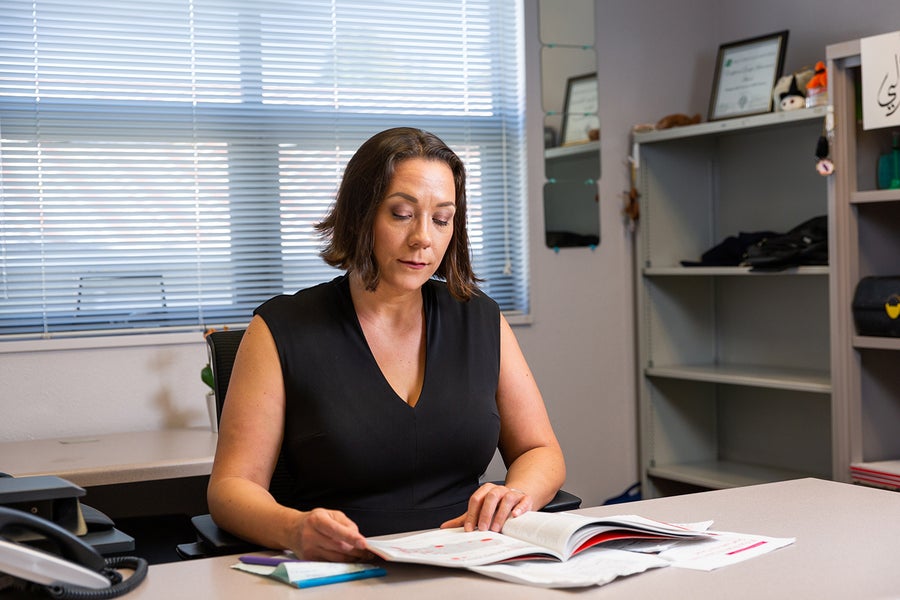Hanging on Kimberly Repp’s office wall in Hillsboro, Ore., is a sign in Latin: “Hic locus est ubi mors gaudet succurrere vitae,” meaning “This is a place where the dead delight in helping the living.”
For medical examiners, it is a mission. Their job is to investigate deaths and learn from them, for the benefit of us all. Repp, however, is not a medical examiner; she is a microbiologist. She is also an epidemiologist for Oregon’s Washington County, where she had been accustomed to studying infectious diseases such as flu or norovirus outbreaks among the living.
But in 2012 she was asked by county officials to look at suicide. The request introduced her to the world of death investigations and also appears to have led to something remarkable: in this suburban county of 600,000, just west of Portland, the suicide rate now is going down. That result is remarkable because national suicide rates have risen, despite decades-long efforts to reverse the deadly trend.
On supporting science journalism
If you're enjoying this article, consider supporting our award-winning journalism by subscribing. By purchasing a subscription you are helping to ensure the future of impactful stories about the discoveries and ideas shaping our world today.
While many factors contribute to suicide, officials here believe they have chipped away at this problem through Repp’s initiative to use data—very localized data that any jurisdiction could collect. Now her mission is to help others learn how to gather and use them.
New York State has just begun testing a system like Repp’s. Humboldt County in California is implementing it. She has gotten inquiries from Utah and Kentucky. Colorado, meanwhile, is using its own brand of data collection to try to achieve the same kind of turnaround.
Following the Death Investigators
Back in 2012, when Repp looked at the available data—mostly statistics reported periodically to the federal Centers for Disease Control and Prevention—she could see that suicide was a big problem and that rates were highest among older white men. But beyond that, the data did not offer a lot of guidance. Plus, they lagged two years behind.
Repp returned to her bosses. “I can tell you who has the highest suicide rate, but I can't tell you what to do about it,” she recalls telling them. “It’s too broad.”
So she turned to the county medical examiner’s death investigators. They gather information at every unnatural death scene to determine the cause (say, drowning or gunshot) and manner (homicide, suicide or accident). It is an important job but a grim one, and it tends to attract unusual personalities.
Repp mustered the courage to introduce herself to one of the investigators, Charles Lovato. “I said, ‘Hi, my name is Kim, and I was hoping to go on a death investigation with you,’” she says. “And he’s like, ‘You’re that weirdo that does outbreak investigations, aren’t you?’ And I’m like, ‘You’re the weirdo that does death investigations.’”

Epidemiologist Kimberly Repp found data in medical examiner reports to reduce suicides. Credit: Adam Wickham KHN
The gambit worked. Repp accompanied Lovato on his grim rounds for more than a year. “Nothing can prepare you for what you’re going to see,” she says. “It gave me a very healthy dose of respect for what they do.”
Repp studied the questions Lovato asked friends and family of the deceased. She watched how he recorded what he saw at the scene. And she saw how a lot of data that helped determine the cause and manner of death never made it into the reports that state and federal authorities use to track suicides. It was a missed opportunity.
Data on the Dead Save Lives
Repp worked with Lovato and his colleagues to develop a new data-collection tool through which investigators could easily record all those details in a checklist. It included not only age and cause of death but also yes/no questions on things such as evidences of alcohol abuse, histories of interpersonal violence, health crises, job losses, and so on.
In addition, the county created a procedure, called a suicide fatality review, to look more closely at these deaths. The review is modeled on child fatality reviews, a now mandatory concept that dates to the 1970s. After getting the okay from family members, key government and community representatives meet to investigate individual suicides with an eye toward prevention. The review group might include health care organizations to look for recent visits to the doctor; veterans’ organizations to check service records; law enforcement; faith leaders; pain-clinic managers; or mental health support groups.
The idea, Repp says, is not to point fingers. It is to look for system-level interventions that might prevent similar deaths. “We were able to identify touch points in our community that we had not seen before,” she adds.
For example, data revealed a surprising number of suicides at hotels and motels. They also showed a number of those who killed themselves had experienced eviction or foreclosure or had a medical visit within weeks or days of their death. And the information revealed that people in crisis regularly turn their pets over to an animal shelter.
But what to do with that information? Experts have long believed that suicide is preventable, and there are evidence-based programs to train people in how to identify and respond to folks in crisis and direct them to help. That is where Debra Darmata, Washington County’s suicide-prevention coordinator, comes in. Part of Darmata’s job involves running these training programs, which she described as like CPR for mental health.
The training is typically offered to people such as counselors, educators or pastors. But with the new data, the county realized it was missing people who may have been the last to see the decedents alive. It began offering the training to motel clerks and housekeepers, animal shelter workers, pain clinic staffers, and more.
It is a relatively straightforward process: Participants are taught to recognize signs of distress. Then they learn how to ask a person if he or she is in crisis. If so, the participants’ role is not to make the person feel better or to provide counseling or anything of the sort. It is to call a crisis line, and the experts will take over from there.
Since 2014, Darmata says that more than 4,000 county residents have received training in suicide prevention. “I’ve worked in suicide prevention for 11 years,” she adds, “and I’ve never seen anything like it.”
The sheriff’s office has begun sending a deputy from its mental health crisis team when doing evictions. And on the eviction paperwork, it added the number for the crisis line and information on a county walk-in mental health clinic. Local health care organizations have new procedures to review cases involving patient suicides, too.
From 2012 to 2018, Washington County’s suicide rate decreased by 40 percent, preliminary data show. To be sure, though, 68 people died by suicide here last year, so preventing even a handful of cases can lower the rate quite a bit.
Spreading the Idea
Repp cautions that the findings cannot be generalized. What is true in suburban Portland may not be true in rural Nebraska or in San Francisco—or even in suburban New Jersey, for that matter. Every community needs to look at its own data.
Still, Jay Carruthers, who runs New York State’s Suicide Prevention Office, saw the potential. “To be able to close the loop and connect [the data] to prevention? That’s the beauty,” he says. This year, the state is beginning to test a similar system in several counties.
In northern California’s Humboldt County, public health manager Dana Murguía had been frustrated for some time that local prevention plans were not making a dent. “I said, ‘We don’t need another plan. We need an operations manual,’” she recalls. “That’s what I feel Dr. Repp has given us.” Humboldt began using a Washington County–style checklist this year, and county officials have identified several unexpected touch points, including public parks and motels where people have died by suicide. Now those sad facts can become action plans.
In Colorado, a different effort to reduce suicides also began with extensive data analysis. There, officials realized that while youth suicide has understandably been a focus, the biggest numbers are among older men. They have not only crafted materials specifically for men in crisis but also for specialized groups, such as veterans, farmers and construction workers.
“What was unexpected to me was how empowering these data would be to so many different people to make change”—including Lovato and the other death investigators, Repp says. “To know that they’re actually keeping the living alive is really powerful.”
Kaiser Health News (KHN) is a nonprofit news service covering health issues. It is an editorially independent program of the Kaiser Family Foundation that is not affiliated with Kaiser Permanente.

